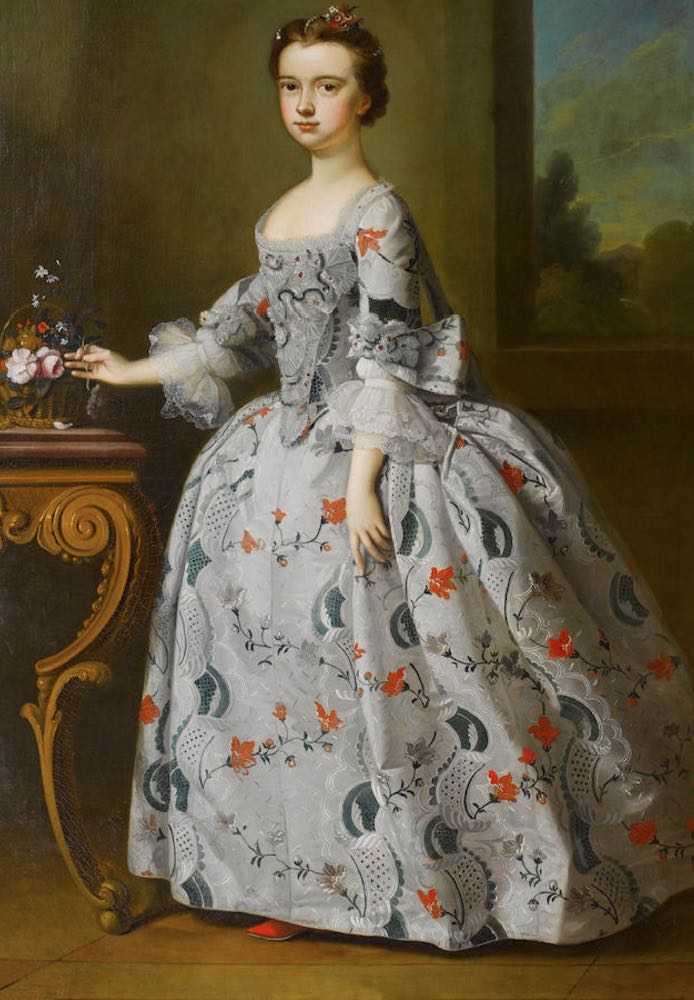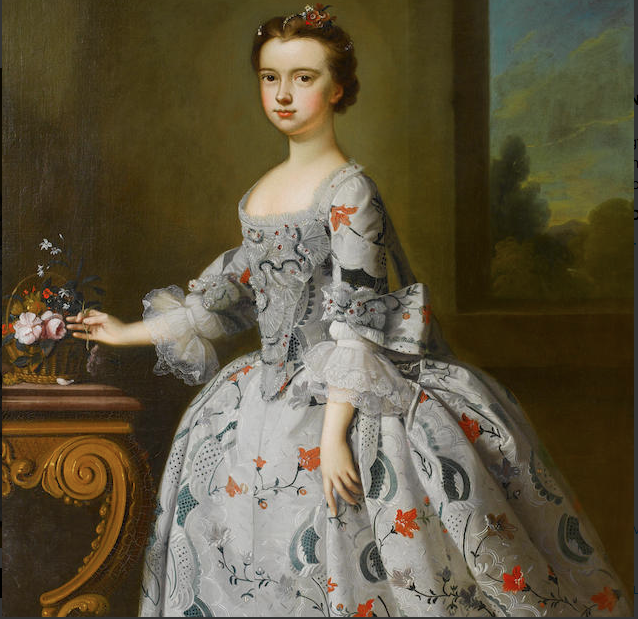This week’s Rate the Dress is chosen from one of my favourite historical eras of all time – at least where fabric is concerned! Will it be as popular as last week’s smash-hit Pingat?
Last week: A very large Pingat ballgown
The very large Pingat ballgown received an equally large and enthusiastic response. The only things it was marked down for were the overly-enthusiastic berthe (as an underly endowed woman, I cannot sympathise, as I need all the help I can get from berthe in 1860s dresses!), and the ‘bookmarks’ on the skirt (another thing I can’t sympathise with. Secret book geek dress sounds like pretty much the best thing ever. Even the colours were book themed!)
The Total: 9.6 out of 10
Undercover nerd dress ftw! Would wear blue silk stockings with any day of the week!
This week: An unknown young lady of ca. 1740
We don’t know the identity of this young lady, or when exactly Bartholemew Dandridge painted her portrait, but we can tell a bit about her from the clues in the painting:

Bartholomew Dandridge (British, 1691-1755) Portrait of a girl with basket of flowers, ca 1740
The girl wears a formal dress in a brocaded silk, with a ca. 1740 design that transitions between the bold colours and unusual shapes that characterised bizarre silks, and the more delicate, naturalistic rococo silks of the mid-18th century. The lacey, lattice-like shapes on the dress are a classic feature of 1740s silks.

Bartholomew Dandridge (British, 1691-1755) Portrait of a girl with basket of flowers, ca 1740
The girl is definitely that. While the full, round skirts, elaborate stomacher, 3/4 length sleeves, and lace-trimmed chemise are all common in fashionable adult dress of the 1740s, the dress bears streamers at the back – typical markers of a girl’s dress. The are usually described as vestigial leading strings, but as they appear primarily in portraits of girls on the brink of adolescence, I also see them as nascent sacque back pleats. They are transitional markers: taking a dress feature associated with childhood (leading strings) and mixing it with a garment feature more common in adult dress (pleats).
So, as an 18th century version of a girls-first formal dress (still sweet and young, but with a few adult features), what do you think of this?
Rate the Dress on a Scale of 1 to 10
A reminder about rating — feel free to be critical if you don’t like a thing, but make sure that your comments aren’t actually insulting to those who do like a garment. Our different tastes are what make Rate the Dress so interesting, but it’s no fun when a comment implies that anyone who doesn’t agree with it, or who would wear a garment, is crazy/totally lacking in taste.
(as usual, nothing more complicated than a .5. I also hugely appreciate it if you only do one rating, and set it on a line at the very end of your comment, so I can find it! Thanks in advance!)

I find this quite lovely. The contrast of the pattern colors on the pearly mauvish-gray ground is subtly pleasing. The design on the stomacher is well-coordinated with the rest, yet different enough to emphasize a small waist. The “bizarre” nature of the pattern is almost an abstract interpretation of floral motifs, so I don’t feel yanked into another century.
10 of 10
Very charming young lady, nice hair style, lovely fabric – and the red shoe peeping out is cute.
She has all the grown-up details, but delicately scaled for her age. I especially like the sleeve bow or whatever it is.
For being what every girl of that era wanted to look like:
10/10
I think the silhouette is graceful, and the dress works well with the girl’s pale skin and chestnut hair. But I don’t like the colors in this dress; the red of the flowers looks odd with the cool blue-grays of the gown.
8 out of 10.
This is not an era that much appeals to me, but I really like the fabrics and how they work together. Possibly because it is for a girl, the dress shape looks more delicate while still fitting into the fashion of the time. So much to my surprise, I actually do like this dress a lot. 9.
I like this. I can guess she feels very sophisticated and grown up.
Even though the dress has the bold patterning, it does not feel as though it is overwhelming her.
I like the pleated organza? sheer fabric on the stomacher. It still helps the dress say feminine, even though the greyish fabric is not overly feminine in itself.
10/10
Excuse me, maybe it’s my bad English, but can you explain what “leading strings” are for? I know that sometimes small kids in the UK have a sort of toddler harness on to keep them from running away, but surely that would just be for small children?
Thanks a lot, Leimomi!
Here you go: https://en.wikipedia.org/wiki/Leading_strings 🙂
I love this dress. I definitely see orange on my screen not red, but either way I lover those bright fiery colours (flame?) on greys. Yum. The sleeves are so sweet.
I am always intrigued by paintings. They are not photographs, and the painter could omit details if s/he cared to do so, yet on this gown the centre front seam is faithfully recreated, right down to the pattern matching being ever so slightly out of alignment. That’s RAD.
9/10
I think this is really lovely. I don’t really like the bows (or whatever they are) on the sleeves, but that is all I dislike. The colours, the silhouette, the red of her shoe, it’s all lovely.
10/10
I think it’s great. The pearl grey colour of the fabric is wonderful, and the orange/red from the pattern is just enough to make it all pop, but without making it too much. Overall it’s a perfect balance combining the best elements in bizarre silks and the later naturalistic patterns, which I think can be too sweet from time to time. The only thing I’m not a fan of are the winged cuffs, but that’s because they are my least favorite cuff style of the period. I don’t dislike them enough to let the take away from my points though.
10/10
Oh she’s a little darling in this dress! I love everything about it. It suits her perfectly.
10/10
I really love this dress, so 10/10!
It’s really charming! There’s definitely something about this dress that’s eye-catching. I’m not sure how I like the sleeves tho. The bizarre silk pattern however is very interesting. Because of the dress’s grey color, it feels very post modern to me? Like someone was trying to deconstruct the pattern, giving this traditional painting a strange vibe? The grey and the orange also match so well. I haven’t seen THAT many dresses from this era but I can’t remember ever seeing this color combination before. Somehow that feels modern to me?
I’m not sure if I’m making sense haha but anyway, the more I look at it, the more I love it!
8/10
🙂 I would wear this in a jiffy.
The apparent weight of that silk is just yummy! The little bursts of the orange-red blossoms draw the eye closer to what might have otherwise been a drab brocade, and the lace on the stomacher is deliciously delicate.
The coordinating shoe finishes the outfit off perfectly.
I honestly can’t fault a thing.
10/10.
Lovely dress for a lovely young lady of around ten or twelve years.
The name of the painter caught my attention, as it is the same as that of Martha Dandridge Custis Washington’s younger brother! A quick search did not reveal any connection, although Martha (and the rest of her siblings) had an English ancestor named Bartholomew Dandridge. Both names are fairly uncommon – and to find them together – twice in approximately the same period; the painter was the elder by about 35 or so years – makes me lean toward the shared ancestor theory.
It would be interesting to discover a connection – especially since the unknown young lady pictured bears a slight resemblance to the young Martha Washington (coloring, facial shape, apparent short stature). The painter never came to America, so it’s just a coincidence – unless he just happened to paint a family member – a young daughter or granddaughter, perhaps? – who just might have been Martha’s distant cousin and who shared some of her DNA. Martha would have been considerably older than the subject of the portrait at the time of its creation.
So, 10/10. Extra point for the history-mystery.
What an interesting theory! I’d say she was more painted in the fashionable style of the era, than really showing specific facial features: huge amounts of female portraiture of this timeperiod show very similar features. She’s also young enough we’d still expect her to be quite petite (you’d never guess it now, but I was the shortest girl in my class until I was 14 years old!), so hard to really draw a link to Martha Washington from either of those. The names are more interesting: Bartholemew was a very common 18th c name, so not much of a clue, but Dandridge might be more uncommon? But then that supposes the model was related to the artist – and more likely she was just a totally unrelated commission.
Beautiful! I love all components of this look but somehow when it’s all together it lacks that WOW visual impact.
8.5
I would love to wear that dress (were I younger and smaller). The colours work really well, the shape is divine and I love all those little details.
10/10
I rather enjoy this dress. I wonder if this fabric is a direct import from Japan or a close copy of something coming out of Japan. The pattern in the fabric may seem strange from a western (especially modern) view, but I have seen this type of brocade in Japan and I think it would make up for a lovely kimono. The grey, slightly orangey red also makes sense in that context. I’m going to give it 10/10 for the possible Japan connection (and also because it is a nice dress)
This dress is definitely made from silk woven in Europe. There was a style of silk popular in the early 18th century, now known as ‘bizarre’ silk, which did use some motifs inspired by Chinese and Indian design, but was entirely European in the final product. This particular one was almost certainly designed and woven at Spitalfields, in London. There might have been some small Japanese influence as well, but it would have been minimal at the most – Japan’s contact with the West was so limited at the time.
I’m not quite sure if it’s the design (frothy sleeves, wide square neckline, floral and lattice motifs) or the off grey colouring, but I don’t find this appealing at all. i give it 6.